|
Chemistry News Archive February 2011
|
Chemistry News February 2011
News of the year 2011 in the fields of chemistry and chemistry-related topics like biochemistry, nantechnology, medicinal chemistry etc.
Main focus: press releases, scientific research results and summaries of chemistry articles, that are published in chemistry journals.
Please send us a eMail to publish your press release here!
|
|
| | | Chemistry: |  |
 |
Scientists synthesize long-sought-after anticancer agent. Image: The authors report an 11-step, enantioselective synthetic route to lomaiviticin aglycon.
|
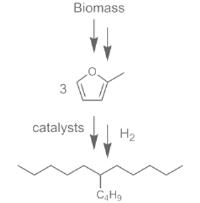 |
Simple, energy-efficient process for producing high-quality fuels from biomass. High-quality liquid fuels are obtained from non-edible carbohydrates by energy-efficient processes. 2-Methylfuran, produced by hydrogenation of furfural, is converted into 6-alkyl undecanes in a catalytic solvent-free process (see scheme with 6-butylundecane). A diesel fuel is produced with an excellent motor cetane number (71) and pour point (-90 °C) and with global process conversions and selectivities close to 90 % [Credit: Angewandte Chemie].
|
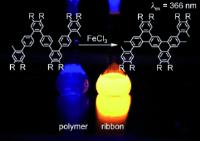 |
Long and narrow, free of defects, and soluble: graphene nanoribbons by bottom-up synthesis. Image: A method for the bottom-up organic synthesis of defect-free graphene nanoribbons in solution has been developed [Credit: Angewandte Chemie].
|
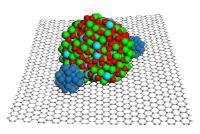 |
Bracing catalyst in material makes fuel cell component work better and last longer. Image: A nanoparticle of indium tin oxide (green and red) braces platinum nanoparticles (blue) on the surface of graphene (black honeycomb) to make a hardier, more chemically active fuel cell material [Credit: Mike Perkins/PNNL].
|
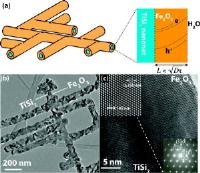 |
Nanonets give rust a boost as agent in water splitting's hydrogen harvest. Nano-scale lattice developed at Boston College a promising platform for clean energy applications. Image: Boston College researchers have tested their Nanonet design as a platform for clean energy applications [Credit: Journal of the American Chemical Society].
|
 |
Researchers discover a new class of magic atomic clusters called superhalogens. Image: Magnetic superoxidizers [Credit: Angewandte Chemie International Edition].
|
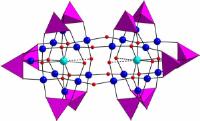 |
Jacobs Scientists Create Palladium-Oxide with Extra High Catalytic Potential. Image: Nobel metal in action: the Polyoxometalate Cu2Pd22P12 [Credit: Angewandte Chemie].
|
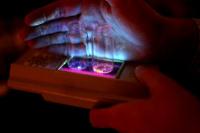 |
Jewel-toned organic phosphorescent crystals: A new class of light-emitting material. Image: Organic phosphors developed at the University of Michigan could one day lead to cheaper organic light-emitting diodes. Here, they glow in blue and orange when triggered by ultraviolet light [Credit: Marcin Szczepanski, U-M College of Engineering].
|
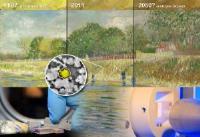 |
X-rays show why van Gogh paintings lose their shine. Image: This illustration shows how X-Rays were used to study why van Gogh paintings lose their shine [Credit: ESRF/Antwerp University/Van Gogh Museum].
|
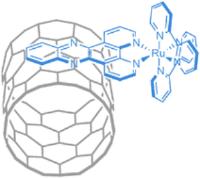 |
Rice University lab uses ruthenium complexes to dissolve nanotubes, add functionality. Image: The dispersion of single-walled carbon nanotubes (SWCNTs) in the presence of water soluble polypyridyl complexes of the general formula [Rux(bpy)yL]2+ (L = dppz, dppn, tpphz) is reported. These ligands have extended planar p systems, which aid in the solubilization of SWCNTs via pi-pi interactions [Credit: ChemComm, RSC, DOI 10.1039/C0CC05295G].
|
| | | Physics: |  |
|
Photon–plasmon coupling: Squeezed Through too Small a Hole - Dye guides light through perforated metal foil.
|
 |
Exploring an 'island of inversion,' physicists find new clues to element synthesis in supernovae. A new discovery, and the questions it raises, could help explain in greater detail how elements are synthesized in stellar explosions - such as the supernova that left behind the Crab Nebula [Credit: VLT/ESO].
|
 |
... to give a new dimension to math: Mathematicians are creating their own version of the periodic table that will provide a vast directory of all the possible shapes in the universe across three, four and five dimensions, linking shapes together in the same way as the periodic table links groups of chemical elements. Image: A slice through one such shape - a cubic threefold [Credit: Imperial College London].
|
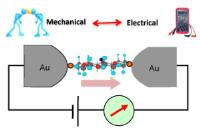 |
Manipulating molecules for a new breed of electronics. Image: When electrical devices are shrunk to a molecular scale, both electrical and mechanical properties of a given molecule become critical [Credit: The Biodesign Institute].
|
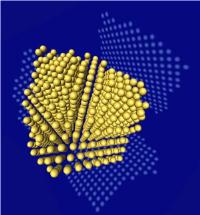 |
For the first time, scientists from Empa and ETH Zurich have, in collaboration with a Dutch team, managed to measure the atomic structure of individual nanoparticles. The technique, recently published in 'Nature', could help better understand the properties of nanoparticles in future. Image: For the first time scientists succeeded in determining the exact spatial arrangement of each single atom in a nanoparticle. The yellow spheres are the graphically depicted atoms that form the silver nanoparticle, which is about two nanometres in diameter [Credit: EMPA].
|
| | | Biochemistry: |  |
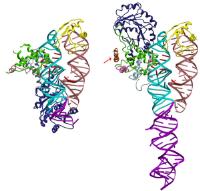 |
Proteins find their way with address label and guide. Image: Structure of SRP without its address label, that is, the signal sequence, (above) and with the signal sequence (right). The signal sequence is marked with a red arrow [Credit: Swedish Research Council].
|
| | | Chemistry and Nanotechnology: |  |
|
Researchers seek to cast light on the phenomena that may occur as nanoobjects interact with cells, tissues, and organisms.
|
| | | Chemistry and Environment: |  |
 |
More mercury is deposited in the Arctic than anywhere else on the planet. Researchers think that one explanation for this may lie in the meteorological conditions in the Arctic spring and summer. Image: Polar bears and humans that eat marine mammals are particularly at risk from the bioaccumulation of mercury in the Arctic [Photo credit: Jenny Bytingsvik, NTNU].
|
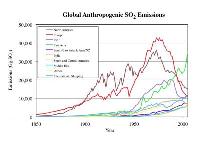 |
Worldwide sulfur emissions rose between 2000-2005, after decade of decline. Shipping, China top emissions growth in new analysis of 150 years of emissions. Image: Manmade sulfur dioxide emissions by country show a decline by the historically large emitters - Europe and the US - but increases in growing economies up to 2005 [Credit: Smith et al., Atmos Chem Phys 2011].
|
| | | More News (open access): |
New high-performance lithium-ion battery 'top candidate'
for electric cars
Scientists are reporting development of
an advanced lithium-ion battery that is ideal for powering
the electric vehicles now making their way into dealer
showrooms. The new battery can store large amounts of energy
in a small space and has a high rate capacity, meaning it
can provide current even in extreme temperatures. A report
on this innovation appears in ACS' Journal of the American
Chemical Society.
Bruno Scrosati, Yang-Kook Sun, and
colleagues point out that consumers have a great desire for
electric vehicles, given the shortage and expense of
petroleum. But a typical hybrid car can only go short
distances on electricity alone, and they hold less charge in
very hot or very cold temperatures. With the government push
to have one million electric cars on U.S. roads by 2015, the
pressure to solve these problems is high. To make electric
vehicles a more realistic alternative to gas-powered
automobiles, the researchers realized that an improved
battery was needed.
The scientists developed a high-capacity,
nanostructured, tin-carbon anode, or positive electrode, and
a high-voltage, lithium-ion cathode, the negative electrode.
When the two parts are put together, the result is a
high-performance battery with a high energy density and rate
capacity. "On the basis of the performance demonstrated
here, this battery is a top candidate for powering
sustainable vehicles," the researchers say.
The authors acknowledge funding from WCU
(World Class University) program through the Korea Science
and Engineering Foundation.
Journal of the American Chemical Society:
"An
Advanced Lithium Ion Battery Based on High Performance
Electrode Materials" [J. Am. Chem. Soc., Article
ASAP; DOI: 10.1021/ja110522x]. |
Needle-in-a-haystack search identifies potential brain
disease drug
Scientists who examined more than 10,000
chemical compounds during the last year in search of
potential new drugs for a group of untreatable brain
diseases, are reporting that one substance shows unusual
promise. The early positive signs for so-called prion
diseases come from research in laboratory mice and cell
cultures, they say in a report in ACS' Journal of Medicinal
Chemistry.
Adam Renslo and colleagues, who include
Nobel Laureate Stanley B. Prusiner, explain that prion
diseases include conditions like mad cow disease in animals
and Creutzfeldt-Jakob Disease in humans, result from
deposits of abnormal prion protein in brain tissue. Prion
diseases are invariably fatal and no treatments are yet
available.
The scientists describe narrowing their
search among the 10,000 candidate drugs to a few dozen of
the most promising and then synthesizing new variations of
the compounds, termed aminothiazoles. Tests on laboratory
mice showed that the new compounds can reach the brain and
reach high concentrations when taken orally and do not
appear toxic. Tests on prion-infected mouse brain cells
showed that the compounds reduced the amount of the abnormal
prion protein. The compounds appear to be among the most
promising potential treatments for prion diseases yet
discovered, the report suggests.
Journal of Medicinal Chemistry: "2-Aminothiazoles
as Therapeutic Leads for Prion Diseases" [J. Med.
Chem., 2011, 54 (4), pp 1010–1021; DOI:
10.1021/jm101250y]. |
High vitamin-D bread could help solve widespread insufficiency problem
With most people unable to get enough
vitamin D from sunlight or foods, scientists are suggesting
that a new vitamin D-fortified food - bread made with
high-vitamin D yeast - could fill that gap. Their study,
confirming that the approach works in laboratory tests,
appears in ACS' Journal of Agricultural and Food Chemistry.
Connie Weaver and colleagues cite studies
suggesting that up to 7 in 10 people in the United States
may not get enough vitamin D, which enables the body to
absorb calcium. Far from just contributing to healthy bones,
however, vitamin D seems to have body-wide beneficial
effects. Vitamin D insufficiency has been linked to an
increased risk of heart disease, cancer, allergy in
children, and other conditions. With few good natural
sources of vitamin D, milk producers long have added it to
milk. Weaver explains, however, that dairy products do not
provide enough. The body makes its own vitamin D when the
skin is exposed to sunlight. But people are not exposed to
sun in winter and are avoiding the sun and using sun blocks
in summer. Scientists thus have been looking for new ways to
add vitamin D to the diet.
Weaver's group did experiments with
laboratory rats, a stand-in for humans in such research,
that ease doubts over whether bread baked with high vitamin
D yeast could be a solution. The doubts originated because
yeast produces one form of the vitamin, termed vitamin D2,
which has been thought to be not as biologically active as
the form produced by sun, vitamin D3. They showed bread made
with vitamin D2-rich yeast, fed to the laboratory rats, had
effects that seemed just as beneficial as vitamin D3. "Our
results suggest that bread made with high vitamin D yeast
could be a valuable new source of vitamin D in the diet,"
they concluded.
The authors acknowledge support from
Lallemand/American Yeast.
Journal of Agricultural and Food
Chemistry: "Bioavailability
and Efficacy of Vitamin D2 from UV-Irradiated Yeast in
Growing, Vitamin D-Deficient Rats" [J. Agric. Food
Chem., Article ASAP, 2011; DOI: 10.1021/jf104679c]. |
Chemistry and Life
The science of chemistry is
Janus-faced. One face embodies the countless services it provides for
mankind; the other, pollution and industrial disasters. Are we right
to trust chemistry, or should we be suspicious of it? Everyone must
make up his or her own mind. Reading the views expressed by the
specialists who have contributed to this special issue – Jean-Marie
Lehn, Michal Meyer, Tebello Nyokong, Anlong Xu, Klaus Lackner and
Akira Suzuki – will help inform this choice:
- The Science and Art of Matter; -
How it all started; - I love laser: it’s my guiding light; - Herbs and
metal; - India’s pharmaceutical boom; - New diet for the ozone eaters;
-Iron tonic for the ocean’s anaemia; - Synthetic trees; - From dark to
green ages; - Letter to a young chemist.
Read More:
Chemistry and Life,
The UNESCO Courier (Januay-March
2011). |
Inhaling 'Red Mud Disaster' dust may not be as harmful to health
as feared
|

|
|
Red mud produced by the recent industrial
accident in Hungary may not be as harmful to health as feared.
Credit: American Chemical Society |
Scientists in Hungary are reporting that the
potential health effects of last October's Red Mud Disaster, one of
the worst environmental accidents in Europe, may be less dangerous
than previously feared. Their study, reported in ACS's journal
Environmental Science and Technology, concludes that the dust from the
mud may be no more harmful than particles of ordinary urban air
pollution.
Mihály Pósfai and colleagues point out that a burst
dam at a factory that processes aluminum ore last October inundated
areas near Ajka in northern Hungary with more than 700,000 cubic yards
of caustic red mud. Ten people died and dozens were injured. Since the
mud contained potentially toxic substances, concern arose about the
health effects of inhaling dust formed when the mud dried and was
swept into the air by wind.
They studied the chemical and physical properties
of the red mud particles and dust and concluded that particles of red
mud dust were too large to be inhaled deeply into lungs, where they
could cause the most damage. Although the resuspension potential of
red mud dust is large, inhalation likely would cause irritation and
coughing, but would not increase the risk of other more serious health
problems, the report suggested.
Environmental Science & Technology: "The
red mud accident in Ajka (Hungary): Characterization and potential
health effects of fugitive dust" [Environ. Sci. Technol.,
2011, 45 (4), pp 1608–1615; DOI: 10.1021/es104005r]. |
Killer paper for next-generation food packaging
Scientists are reporting development and
successful lab tests of "killer paper," a material intended
for use as a new food packaging material that helps preserve
foods by fighting the bacteria that cause spoilage. The
paper, described in ACS's journal, Langmuir, contains a
coating of silver nanoparticles, which are powerful
anti-bacterial agents. Aharon Gedanken and
colleagues note that silver already finds wide use as a
bacteria fighter in certain medicinal ointments, kitchen and
bathroom surfaces, and even odor-resistant socks. Recently,
scientists have been exploring the use of silver
nanoparticles - each 1/50,000 the width of a human hair - as
germ-fighting coatings for plastics, fabrics, and metals.
Nanoparticles, which have a longer-lasting effect than
larger silver particles, could help overcome the growing
problem of antibiotic resistance, in which bacteria develop
the ability to shrug-off existing antibiotics. Paper coated
with silver nanoparticles could provide an alternative to
common food preservation methods such as radiation, heat
treatment, and low temperature storage, they note. However,
producing "killer paper" suitable for commercial use has
proven difficult. The scientists describe
development of an effective, long-lasting method for
depositing silver nanoparticles on the surface of paper that
involves ultrasound, or the use of high frequency sound
waves. The coated paper showed potent antibacterial activity
against E. coli and S. aureus, two causes of bacterial food
poisoning, killing all of the bacteria in just three hours.
This suggests its potential application as a food packaging
material for promoting longer shelf life, they note.
Langmuir: "Sonochemical
Coating of Paper by Microbiocidal Silver Nanoparticles"
[2011, 27 (2), pp 720–726; DOI: 10.1021/la103401z]. |
The race to bring biofuels to the pump
Poised at the starting gate are palm oil,
sugar cane, corn cobs, and switch grass. On your mark, get
set... This is not a race among fruits and vegetables, but
instead a real-life contest to decide which biofuel raw
materials and technologies make it to the gas pump. That
quest to develop a sustainable supply of affordable biofuels
and bring them to the market is the topic of the cover story
in the current edition of Chemical and Engineering News
(C&EN), ACS's weekly newsmagazine.
C&EN Senior Correspondent Stephen Ritter
notes that scientists have largely met the technical
challenges of developing biofuels - fuels made from
renewable biological resources - to
supplement and eventually replace gasoline and diesel fuel.
Starting points for biofuels include sugars, starches,
vegetable oils, recycled paper, and other biomass. All of
those materials can be processed into fuels. The benefits
include energy security by eliminating dependence on
imported oil and a reduction in the carbon dioxide emissions
that contribute to global warming. But the technological fog of uncertainties obscures the road
to the finish line. One major problem, for example, involves
the logistics of biomass availability, transport, and
storage. To be commercially viable, biomass fuel factories
will need up to 30 million pounds of biomass per day.
Fermentation facilities, which convert sugar to ethanol,
would need about 10 million pounds. To win, companies must
develop long-term reliable feedstock supplies and find
partners to buy and market their fuel. Chemical and Engineering News: "Race
to the Pump" [Volume
89, Number7, February 14,2011, DOI:
10.1021/CEN020911090424]. |
First identification of endocrine disruptors in algae
blooms
Scientists are reporting for the first
time that previously unrecognized substances released by
algae blooms have the potential to act as endocrine
disruptors, which can interfere with the normal activity of
reproductive hormones. The effect is not caused by
microcystin toxins, long recognized as potentially harmful
to humans and aquatic animals, but as yet unidentified
substances. As a result, the scientists are calling for a
revision of environmental monitoring programs to watch for
these new substances. The findings appear in ACS's journal
Environmental Science and Technology.
Theodore Henry and colleagues note that harmful blooms of
toxin-producing algae, called cyanobacteria or blue-green
algae, occur in waters throughout the world and are a
growing health and environmental concern. The algae produce
microcystins that can harm fish, plants, and human health.
Possible human health effects include skin rashes, fever,
and liver damage. Although scientists have focused mainly on
microcystins' biological effects, new evidence suggests that
other potentially harmful substances also may be present.
In an effort to find out, Emily Rogers supervised by
Theodore Henry, and co-authors Michael Twiner, Julia
Gouffon, Jackson McPherson, Gregory Boyer, Gary Sayler, and
Steven Wilhelm turned to zebrafish, often used as a stand-in
for people and other animals in laboratory experiments. They
found that something released by algae, other than
microcystins, had an endocrine disrupting effect on the
fish. The report recommends that environmental protection
agencies may need to update monitoring programs for algae
blooms to include potential endocrine-disrupting substances.
The scientists acknowledge funding from the National Oceanic
and Atmospheric Administration.
Environmental Science & Technology: "Global
gene expression profiling in larval zebrafish exposed to
microcystin-LR and Microcystis reveals endocrine disrupting
effects of cyanobacteria" [Environ. Sci. Technol.,
Article ASAP; DOI: 10.1021/es103538b]. |
Greener process for key ingredient for everything from
paint to diapers
Scientists are reporting discovery of an
environmentally friendly way to make a key industrial
material - used in products ranging
from paints to diapers - from a
renewable raw material without touching the traditional
pricey and increasingly scarce petroleum-based starting
material. Their report on a new catalyst for making acrylic
acid appears in ACS Catalysis, the newest in the American
Chemical Society's suite of 39 peer-reviewed scientific
journals. Weijie Ji, Chak-Tong Au, and colleagues note that acrylic
acid is essential for making paints, adhesives, textiles,
leather treatments, and hundreds of other products. Global
demand for the colorless liquid totals about 4 million tons
annually. Acrylic acid is typically made from propylene
obtained from petroleum. With prices rising, manufacturers
have been seeking alternative ways of making acrylic acid
without buying propylene. One possibility involves making it
from lactic acid. But current processes for using lactic
acid are inefficient, less selective, and require higher
temperatures and the accompanying high inputs of energy. The scientists' potential solution is a new catalyst that
can convert lactic acid into acrylic acid more efficiently.
Lactic acid is a classic renewable starting material,
produced by bacteria growing in vats of biomass such as
glucose and starch from plants. In laboratory studies, the
scientists showed that the new catalyst can convert lactic
acid to acrylic acid more selectively at lower temperatures.
This could mean better use of lactic acid, lower fuel
consumption, and less impact on the environment, the
scientists suggest. ACS Catalysis: "Efficient Acrylic Acid Production through
Bio Lactic Acid Dehydration over NaY Zeolite Modified by
Alkali Phosphates" [ACS Catal., 2011, 1 (1), pp 32–41; DOI:
10.1021/cs100047p]. |
Toward a fast, simple test for detecting cholera rampaging in 40 countries
With cholera on the rampage in Haiti and
almost 40 other countries, scientists are reporting the
development of a key advance that could provide a fast,
simple test to detect the toxin that causes the disease. The
report appears in ACS' journal Bioconjugate Chemistry.
Cholera affects more than 200,000 people annually, mainly in
developing countries, and causes about 5,000 deaths. Many
involve infants, children, and the elderly.
J. Manuel Perez and colleagues note that cholera is an
intestinal infection from food or water contaminated with
the bacterium Vibrio cholerae. It produces a toxin that can
cause severe diarrhea, which can lead to rapid dehydration
and death. Prompt treatment thus is essential, and yet
existing tests to diagnose cholera are time-consuming,
expensive, and require the use of complex equipment. The scientists describe a key advance toward a better,
faster test. The new method uses specially prepared
nanoparticles of iron oxide, each barely 1/50,000th the
width of a single human hair, coated with a type of sugar
called dextran. To achieve this, they looked for specific
characteristics of the cholera toxin receptor (GM1) found on
cells' surface in the victim's gut, and then they introduced
these features to their nanoparticles. When the magnetic
nanoparticles are added to water, blood, or other fluids to
be tested, the cholera toxin binds to the nanoparticles in a
way that can be easily detected by instruments. The test
hardware can be turned into portable gear that health care
workers could use in the field, the scientists say. The
approach also shows promise for treating cholera
intoxication. The authors acknowledge funding from the National Institute
of General Medical Sciences at the National Institutes of
Health. Bioconjugate Chemistry: "Identification of
Molecular-Mimicry-Based Ligands for Cholera Diagnostics
using Magnetic Relaxation" [Bioconjugate Chem., Article
ASAP; DOI: 10.1021/bc100442q]. |
Chocolate is a 'Super Fruit'
It is widely known that fruit contains
antioxidants which may be beneficial to health. New research
published in the open access journal Chemistry Central
Journal demonstrates that chocolate is a rich source of
antioxidants and contains more polyphenols and flavanols
than fruit juice.
When researchers at the Hershey Center
for Health & Nutrition™ compared the antioxidant activity in
cocoa powder and fruit powders they found that, gram per
gram, there was more antioxidant capacity, and a greater
total flavanol content, in the cocoa powder.
Similarly when they compared the amount
of antioxidants, per serving, of dark chocolate, cocoa, hot
chocolate mix and fruit juices they found that both dark
chocolate and cocoa had a greater antioxidant capacity and a
greater total flavanol, and polyphenol, content than the
fruit juices. However hot chocolate, due to processing
(alkalization) of the chocolate, contained little of any.
Dr Debra Miller, the senior author of the
paper, says that, “Cacao seeds are a “Super Fruit” providing
nutritive value beyond that of their macronutrient
composition”. Which is great news for chocolate lovers.
Chemistry Central Journal: "Cacao
seeds are a 'Super Fruit': A comparative analysis of various
fruit powders and products"
[2011, 5:5, 7 February 2011]. |
Air pollutants from fireplaces and wood-burning stoves
raise health concerns
WASHINGTON - With millions of people
warding off winter's chill with blazing fireplaces and
wood-burning stoves, scientists are raising red flags about
the potential health effects of the smoke released from
burning wood. Their study, published in the American
Chemical Society's (ACS') journal, Chemical Research in
Toxicology, found that the invisible particles inhaled into
the lungs from wood smoke may have several adverse health
effects. It is among 39 peer-reviewed scientific journals
published by ACS, the world's largest scientific society.
Steffen Loft, Ph.D., and colleagues cite
the abundant scientific evidence linking inhalation of fine
particles of air pollution - so-called "particulate matter" - from
motor vehicle exhaust, coal-fired electric power plants, and
certain other sources with heart disease, asthma, bronchitis
and other health problems. However, relatively little
information of that kind exists about the effects of wood
smoke particulate matter (WSPM), even though millions of
people around the world use wood for home heating and
cooking and routinely inhale WSPM.
The scientists analyzed and compared
particulate matter in air from the center of a village in
Denmark where most residents used wood stoves to a
neighboring rural area with few wood stoves, as well as to
pure WSPM collected from a wood stove. Airborne particles in
the village and pure WSPM tended to be of the most
potentially hazardous size - small
enough to be inhaled into the deepest parts of the lungs.
WSPM contained higher levels of polycyclic aromatic
hydrocarbons (PAHs), which include "probable" human
carcinogens. When tested on cultures of human cells, WSPM
also caused more damage to the genetic material, DNA; more
inflammation; and had greater activity in turning on genes
in ways linked to disease.
The authors acknowledged funding from the
National Research Councils, Denmark; and the Danish
Environmental Protection Agency.
Chemical Research in Toxicology: "Oxidative
Stress, DNA Damage, and Inflammation Induced by Ambient Air
and Wood Smoke Particulate Matter in Human A549 and THP-1
Cell Lines" [Chem. Res. Toxicol., Article ASAP;
DOI: 10.1021/tx100407m]. |
Vegans' elevated heart risk requires omega-3s and B12
People who follow a vegan lifestyle -
strict vegetarians who try to eat no meat or animal products
of any kind - may increase their risk of developing blood
clots and atherosclerosis or "hardening of the arteries,"
which are conditions that can lead to heart attacks and
stroke. That's the conclusion of a review of dozens of
articles published on the biochemistry of vegetarianism
during the past 30 years. The article appears in ACS'
bi-weekly Journal of Agricultural and Food Chemistry.
Duo Li notes in the review that meat eaters are known for
having a significantly higher combination of cardiovascular
risk factors than vegetarians. Lower-risk vegans, however,
may not be immune. Their diets tend to be lacking several
key nutrients - including iron, zinc, vitamin B12, and
omega-3 fatty acids. While a balanced vegetarian diet can
provide enough protein, this isn't always the case when it
comes to fat and fatty acids. As a result, vegans tend to
have elevated blood levels of homocysteine and decreased
levels of HDL, the "good" form of cholesterol. Both are risk
factors for heart disease. It concludes
that there is a strong scientific basis for vegetarians and
vegans to increase their dietary omega-3 fatty acids and
vitamin B12 to help contend with those risks. Good sources
of omega-3s include salmon and other oily fish, walnuts and
certain other nuts. Good sources of vitamin B12 include
seafood, eggs, and fortified milk. Dietary supplements also
can supply these nutrients. Journal of
Agricultural and Food Chemistry: "Chemistry
behind Vegetarianism" [J. Agric. Food Chem.,
2011, 59 (3), pp 777–784]. |
New gift from Mother Nature’s medicine chest may help
prevent and treat bone diseases
One of Mother Nature's latest gifts to
medical science is stirring excitement with the discovery
that the substance - obtained from a
coral-reef inhabiting cyanobacterium - appears to be an
ideal blueprint for developing new drugs for serious
fractures, osteoporosis, and other bone diseases. That's the
conclusion of a study on the substance, Largazole, in the
journal ACS Medicinal Chemistry Letters. By some estimates, more than half of today's medications are
in Largazole's family, the "natural products." They come
from trees, snails, scorpion venom, soil bacteria, other
plants and animals; however, so far only a few come from the
ocean. In the report, Jiyong Hong, Seong Hwan Kim, Hendrik
Luesch and colleagues indicate that Largazole was derived
from and named for marine cyanobacteria that grow in Key
Largo, Florida. Largazole, they add, already has attracted
scientific attention for its ability to kill cancer cells in
laboratory experiments. Their research in laboratory dishes and test animals showed
that Largazole has an unusual dual action on injured or
diseased bones. It stimulates a process in the body called
osteogenesis, which involves the growth of new bone and the
repair of damaged bone. Largazole also blocks the oppose
process in which the body naturally breaks down and resorbs
bone. Both of those benefits, the scientists found, come
from Largazole's effects on proteins called histone
deacetylases, which are a sort of master control switch for
protein production. Drugs that block histone deacetylases
are currently used to treat cancer, and they may have other
health benefits as well. The researchers also showed that
Largazole mixed with collagen and calcium phosphate, bone
components, helped heal fractured bones in laboratory mice
and rabbits. ACS Medicinal Chemistry Letters: "In Vitro and In Vivo
Osteogenic Activity of Largazole" [ACS Med. Chem. Lett.,
Article ASAP, 2011; DOI: 10.1021/ml1002794]. |
'Red mud' disaster's main threat to crops is not toxic
metals
As farmers in Hungary ponder spring
planting on hundreds of acres of farmland affected by last
October's red mud disaster, scientists are reporting that
high alkalinity is the main threat to a bountiful harvest,
not toxic metals. In a study in the ACS journal
Environmental Science & Technology, they also describe an
inexpensive decontamination strategy using the mineral
gypsum, an ingredient in plaster. Erik
Smolders and colleagues note that a dam burst at a factory
processing aluminum ore, flooding the surrounding land with
more than 700,000 cubic yards of a byproduct termed red mud.
At least 10 people died and hundreds were injured in
Hungary's worst-ever environmental disaster. Red mud
contains toxic metals like arsenic, chromium, cadmium and
nickel. The mud also contains radioactive elements and is
highly alkaline, caustic enough to burn skin and eyes. On
the scale for measuring acidity or alkalinity, 7 is neutral,
anything above 7 is alkaline and below is acid. Red mud is
about one million times more alkaline than a neutral
material. With up to 4 inches of red mud coating farmland,
concerns arose about red mud's potential impact on the 2011
planting of corn, alfalfa, and other crops. With little
scientific knowledge about red mud's effects on plant
growth, much of the concern focused on toxic metals.
The scientists' tests showed that plants in contaminated
soil grew about 25 percent slower than crops grown in
uncontaminated soil. The main culprit, however, appeared to
be not toxic metals or radioactivity, but red mud's intense
alkalinity and salt content. Adding gypsum to the red mud
can reduce alkalinity and will accelerate the removal of the
salts, the scientists add, recommending long-term monitoring
of metals in the crops to remove any concerns with food
chain contamination. Environmental Science
& Technology: "The
Red Mud Accident in Ajka (Hungary): Plant Toxicity and Trace
Bioavailability in Red Mud Contaminated Soil" [Environ.
Sci. Technol., Article ASAP, 2011; DOI:
10.1021/es104000m]. |
Shoo fly: Catnip oil repels bloodsucking flies
Catnip, the plant that attracts domestic
cats like an irresistible force, has proven 99 percent
effective in repelling the blood-sucking flies that attack
horses and cows, causing $2 billion in annual loses to the
cattle industry. That's the word from a report published in
ACS' biweekly Journal of Agricultural and Food Chemistry.
Junwei Zhu and colleagues note that stable flies not only
inflict painful bites, but also transmit multiple diseases.
Cattle harried by these bloodsuckers may produce less meat
and milk, have trouble reproducing, and develop diseases
that can be fatal. All traditional methods for controlling
stable flies - even heavy
applications of powerful insecticides - have proven less than effective. The scientists thus turned
to catnip oil, already known to repel more than a dozen
families of insects, including house flies, mosquitoes and
cockroaches. They made pellets of catnip
oil, soy, and paraffin wax, and spread them in a cattle
feedlot. Within minutes, the pellets shooed the flies away,
with the repellent action lasting for about three hours.
Pellets without catnip oil, in contrast, had no effect. The
scientists now are working on making the repellent action
last longer, which they say is the key to putting catnip to
use in protecting livestock both in feedlots and pastures.
Journal of Agricultural and Food Chemistry "Repellency of a
Wax-Based Catnip-Oil Formulation against Stable Flies" [J.
Agric. Food Chem., 2010, 58 (23), pp 12320–12326; DOI:
10.1021/jf102811k]. |
Secrets of plant warfare underpin quest for safer, more secure global food supply
Like espionage agents probing an enemy's
fortifications, scientists are snooping out the innermost
secrets of the amazing defense mechanisms that plants use to
protect themselves from diseases. The effort - intended to discover ways of bolstering those
natural defenses and enhance the safety and security of the
global food supply - is the topic of
an article in the current edition of Chemical & Engineering
News (C&EN), ACS' weekly newsmagazine.
C&EN Associate Editor Sarah Everts notes
that plants use a battery of cunning mechanisms to protect
themselves from disease. When microbes breach those immune
defenses, epidemics like the Irish potato famine or wheat
stem rust can mean starvation and displacement for millions
of people.
The article describes how scientists are
intensively studying plant immune mechanisms. Over the last
20 years, for instance, scientists have made inroads into
the complex chemical architecture of those defenses. The
insights include the identification of a gene for the first
receptor protein involved in plant immunity as well as the
discovery of plant structures that recognize invading
microorganisms. Those and other insights could underpin
development of more effective and more sustainable ways of
fighting crop pests.
Chemical & Engineering News: "Vegetative
Warfare" [Volume 89, number 5, pp 53-55]. |
|
|



